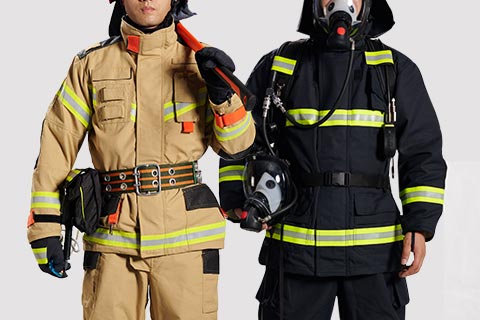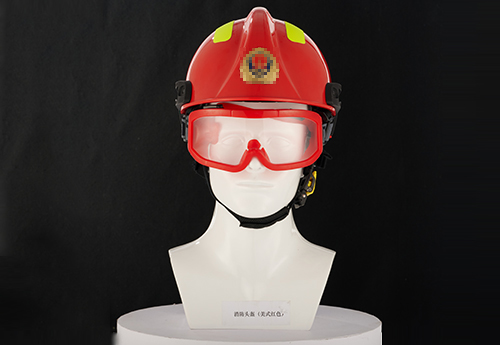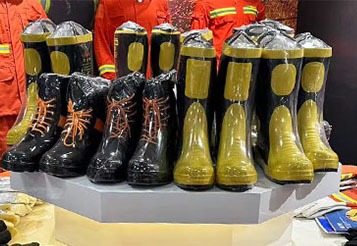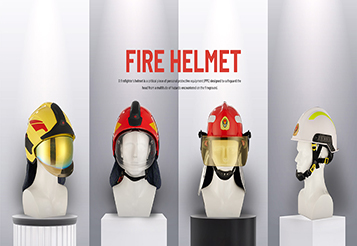How a Firefighting Helmet is Made
As the key safety equipment for firefighters during rescue and rescue, firefighting helmets play an important role in extreme environments such as high temperatures, impacts and flames, and can provide comprehensive protection for firefighters' heads. The following is a detailed introduction to the process of making firefighting helmets, including the selection of materials and production processes, to give you a clear understanding of the core points of firefighting helmets adapted to firefighting scenarios.

Firefighting Helmet Shell: Shell is the first line of defence of thefirefighting helmet, need to be able to maintain a short period of time in a high temperature environment without deformation, can withstand the impact of falling objects, but also have the ability to prevent puncture, and at the same time the weight should be light, to reduce the burden on the firefighter's neck.
Aramid composite material: compounded by aramid fibres and high temperature resistant resin, it has excellent heat resistance and can withstand direct burning of high temperature flames without melting, with high strength and light weight, but with higher cost, it is mostly used in special firefighting helmets, such as forest firefighting, chemical rescue and other scenarios.
Modified polycarbonate (PC): after flame-retardant treatment, it has a certain degree of heat resistance and impact resistance, lower cost, suitable for basic firefighting helmets, but it is easy to be deformed under long-term high-temperature environments, and it is mostly used in lower-risk firefighting scenarios.
Composite buffer layer: the high-endfirefighting helmet adopts the double-layer structure of ‘flame retardant EPS + elastomer’, the outer layer of EPS can cope with severe impacts, while the inner layer of elastomer can cushion high-frequency vibration and reduce concussive injuries to the brain, and the elastomer can also withstand a certain degree of high temperature, which is suitable for prolonged periods of time in a high-temperature environment. The elastomer can also withstand high temperature, which is suitable for long time in high temperature environment.
Shawl: Selected aramid canvas, flame retardant performance in line with relevant standards, can protect the neck and shoulders from flame burns.
Fixed belt and liner: the fixed belt is made of flame-retardant nylon, which is strong and not easy to break; the liner is made of high-temperature-resistant knitted fabric containing aramid fibres, which is both breathable and fireproof, avoiding the firefighters from feeling stuffy and uncomfortable when they wear it for a long period of time.
High-temperature molding (for composite materials): the aramid fiber prepreg according to a certain number of layers laid into the mold, each layer of fibers in the direction of staggered in order to enhance the impact resistance; the mold is heated to a certain temperature, applying a certain pressure, and keep it for a period of time to allow the resin to solidify; sandblasting after demolding, to remove the surface burrs, to ensure that the surface of the shell is smooth and free of air bubbles to avoid cracking at high temperatures. Cracking.
Injection moulding (for reinforced polyamide): mix polyamide particles with glass fibre in proportion and then heat and melt; inject into the mould at a certain pressure and demould after cooling; after that, carry out aging treatment to eliminate internal stresses and prevent deformation at a later stage.
Flame-retardant EPS liner moulding: pre-foam the polystyrene particles with flame-retardant agent; inject into the liner mould and heat the foam to form the liner, which has a higher density than the liner of ordinary helmets to enhance the shock-absorbing effect; reserve the connecting groove with the outer shell during the cutting process to ensure that it will not loosen up after the assembling process.
Mask and shawl processing: after the mask is injection moulded, it is sprayed with anti-fog coating and tested at high temperature to ensure that the coating will not fall off; after the shawl is cut and edges are locked, it is sewn and connected to the snap buttons at the back of the outer shell to ensure that it is firmly connected and avoid falling off during the rescue process.
The assembly process to ensure that the components are linked reliably, in the shell on the inside coated with high temperature adhesive, embedded in the liner and cured under pressure; fixed band through the stainless steel rivets fixed to both sides of the shell, the rivets should be rust-proof treatment, to ensure the firmness of the mask through the metal hinges and the shell connected to the shell to be able to open and close many times without jamming; installation of adjustable knobs, fine-tuning of the head circumference to ensure that the wearer will not be shaken front to back and side to side.
In terms of intelligent perception, the built-in temperature sensor can monitor the environmental temperature in real time, and will alarm if it exceeds a certain limit; the three-axis acceleration sensor can automatically send a distress signal when the firefighter falls.
In terms of communication enhancement, the integrated bone conduction headset and microphone can achieve clear calls in noisy environments, and is also compatible with the fire command system. Lightweight upgrades include a carbon-fibre-aramid hybrid material to reduce the weight of the helmet and reduce firefighter neck fatigue.
In terms of modular design, the mask and cape can be quickly detached to suit different rescue scenarios, such as lightweight for urban rescue and full protection for forest fire rescue.
Firefighting Helmets Structure and Functional Requirements
The biggest difference between a firefighting helmet and an ordinary helmet is that it needs to deal with high temperature, flame, falling objects, chemical corrosion and other risks, and its structural design must comply with the relevant standards. The core structure of a firefighting helmet consists of an outer shell, an inner liner, a cushioning layer, a face shield, a cape and a fixation system.
Firefighting Helmet Shell: Shell is the first line of defence of thefirefighting helmet, need to be able to maintain a short period of time in a high temperature environment without deformation, can withstand the impact of falling objects, but also have the ability to prevent puncture, and at the same time the weight should be light, to reduce the burden on the firefighter's neck.
Firefighting Helmet Lining and Cushioning Layer
Lining and cushioning layer need to have flame retardant and shock-absorbing properties, the cushioning layer can absorb the impact through its own deformation, reduce the head injury during the collision, and both should be able to withstand a certain amount of high temperature, to avoid failure in a high temperature environment.Firefighting Helmet Auxiliary Components
Auxiliary components are also critical, anti-fog and anti-scratch visor to protect the face from flames and splashes; flame-retardant cape to protect the neck and shoulders; adjustable fixation straps to ensure that the helmet will not fall off during strenuous exercise, these components should be adapted to the demanding requirements of firefighting scenarios.Material Selection for firefighting Helmets
Fire helmet materials to find a balance between heat resistance, strength, flame retardant and weight, the choice of materials for different components is directly related to its protective effect at the fire scene.Shell Materials
Reinforced polyamide (PA66 + glass fibre): this material is better heat resistance, can remain stable within a certain temperature range, impact resistance, the cost is also relatively moderate, is the commonly used materials in high-end firefighting helmets. After adding glass fibre, its strength will be significantly improved, and it can effectively resist the impact of falling objects.Aramid composite material: compounded by aramid fibres and high temperature resistant resin, it has excellent heat resistance and can withstand direct burning of high temperature flames without melting, with high strength and light weight, but with higher cost, it is mostly used in special firefighting helmets, such as forest firefighting, chemical rescue and other scenarios.
Modified polycarbonate (PC): after flame-retardant treatment, it has a certain degree of heat resistance and impact resistance, lower cost, suitable for basic firefighting helmets, but it is easy to be deformed under long-term high-temperature environments, and it is mostly used in lower-risk firefighting scenarios.
Lining and Cushioning Layer
Fame-retardant EPS foam: this is the basic liner material, which is self-extinguishing from fire by adding flame retardant, and at the same time maintains the good shock-absorbing performance of EPS, which can absorb most of the impact during the crash.Composite buffer layer: the high-endfirefighting helmet adopts the double-layer structure of ‘flame retardant EPS + elastomer’, the outer layer of EPS can cope with severe impacts, while the inner layer of elastomer can cushion high-frequency vibration and reduce concussive injuries to the brain, and the elastomer can also withstand a certain degree of high temperature, which is suitable for prolonged periods of time in a high-temperature environment. The elastomer can also withstand high temperature, which is suitable for long time in high temperature environment.
Auxiliary Component Materials
Mask: made of anti-fog polycarbonate (PC) with a wear-resistant coating, it has good light transmission, maintains a clear field of vision over a wide range of temperatures, and protects against the impact of debris.Shawl: Selected aramid canvas, flame retardant performance in line with relevant standards, can protect the neck and shoulders from flame burns.
Fixed belt and liner: the fixed belt is made of flame-retardant nylon, which is strong and not easy to break; the liner is made of high-temperature-resistant knitted fabric containing aramid fibres, which is both breathable and fireproof, avoiding the firefighters from feeling stuffy and uncomfortable when they wear it for a long period of time.
Firefighting Helmet Production Process
The production of firefighting helmets has to ensure stable performance in extreme environments, and its process link pays more attention to the consistency of the material and the reliability of the structure than that of ordinary helmets.Mould Design: Adapting to Head Structure and Protection Needs
The mould design is based on the ergonomic data of firefighting scenarios, with a wider range of head circumference adaptability, and space reserved for wearing an air respirator; the shell curvature adopts a ‘convex front and curved back’ design, with the front protruding a little bit to protect the forehead, and the back extending a part to protect the back of the neck; the mould material is designed to protect the back of the neck; the mould is designed to protect the forehead and the neck. A part to protect the back of the neck; mould material for high temperature alloy, to ensure that no deformation in high temperature molding, precision control is very strict. 2.Shell Moulding: Performance Lock Under High Temperature and Pressure
According to different materials, there are two main shell moulding processes.High-temperature molding (for composite materials): the aramid fiber prepreg according to a certain number of layers laid into the mold, each layer of fibers in the direction of staggered in order to enhance the impact resistance; the mold is heated to a certain temperature, applying a certain pressure, and keep it for a period of time to allow the resin to solidify; sandblasting after demolding, to remove the surface burrs, to ensure that the surface of the shell is smooth and free of air bubbles to avoid cracking at high temperatures. Cracking.
Injection moulding (for reinforced polyamide): mix polyamide particles with glass fibre in proportion and then heat and melt; inject into the mould at a certain pressure and demould after cooling; after that, carry out aging treatment to eliminate internal stresses and prevent deformation at a later stage.
Lining and Component Processing: Flame-retardant and Compatibility are Both Important.
Flame-retardant EPS liner moulding: pre-foam the polystyrene particles with flame-retardant agent; inject into the liner mould and heat the foam to form the liner, which has a higher density than the liner of ordinary helmets to enhance the shock-absorbing effect; reserve the connecting groove with the outer shell during the cutting process to ensure that it will not loosen up after the assembling process.
Mask and shawl processing: after the mask is injection moulded, it is sprayed with anti-fog coating and tested at high temperature to ensure that the coating will not fall off; after the shawl is cut and edges are locked, it is sewn and connected to the snap buttons at the back of the outer shell to ensure that it is firmly connected and avoid falling off during the rescue process.
Assembly: Synergistic Adaptation of Multiple Components
The assembly process to ensure that the components are linked reliably, in the shell on the inside coated with high temperature adhesive, embedded in the liner and cured under pressure; fixed band through the stainless steel rivets fixed to both sides of the shell, the rivets should be rust-proof treatment, to ensure the firmness of the mask through the metal hinges and the shell connected to the shell to be able to open and close many times without jamming; installation of adjustable knobs, fine-tuning of the head circumference to ensure that the wearer will not be shaken front to back and side to side.
Inspection: Simulate the Performance Verification of Extreme Scenes
The inspection standard of firefighting helmets is much higher than that of ordinary helmets, and the core tests include high-temperature impact test, puncture test, flame-retardant performance test and wear stability test.High-Temperature Impact Test
High-temperature impact test is the helmet placed in a high-temperature environment for a period of time after the impact of the fall test, the requirements of the shell does not rupture and the impact on the head in the safe range; puncture test is to use a steel cone from a certain height to fall, test the helmet's anti-puncture ability;Flame Retardant Performance Test
Flame retardant performance test is to test the shell and cape in the flame burns the performance of the helmet;Wear Stability Test
wear stability test is a simulation of firefighters in a variety of actions to ensure that the helmet will not be shifted, the fastening strap will not be loose, the helmet will not move, the helmet will not be loose. will not shift and the fixing strap will not loosen.The Development Trend of Firefighting Helmets
With the upgrading of firefighting and rescue needs, firefighting helmets are developing in the direction of ‘multi-functional integration’.In terms of intelligent perception, the built-in temperature sensor can monitor the environmental temperature in real time, and will alarm if it exceeds a certain limit; the three-axis acceleration sensor can automatically send a distress signal when the firefighter falls.
In terms of communication enhancement, the integrated bone conduction headset and microphone can achieve clear calls in noisy environments, and is also compatible with the fire command system. Lightweight upgrades include a carbon-fibre-aramid hybrid material to reduce the weight of the helmet and reduce firefighter neck fatigue.
In terms of modular design, the mask and cape can be quickly detached to suit different rescue scenarios, such as lightweight for urban rescue and full protection for forest fire rescue.
Conclusion
The production of the firefighting helmet integrates the knowledge of material science and extreme environmental engineering. From the selection of high-temperature-resistant composite materials, to the precision shaping of high-temperature moulding, to the rigorous testing of simulated fire scenarios, every step revolves around the core objective of ‘guarding lives in the most dangerous environments’. As technology advances, thefirefighting helmet will continue to improve in safety, comfort and intelligence, becoming a more reliable ‘head shield’ for firefighters.
Next Article:
Last Article:
Request A Quote
Related News
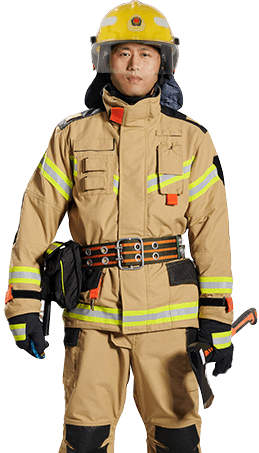
Quick Consultation
We are looking forward to providing you with a very professional service. For any
further information or queries please feel free to contact us.

